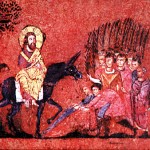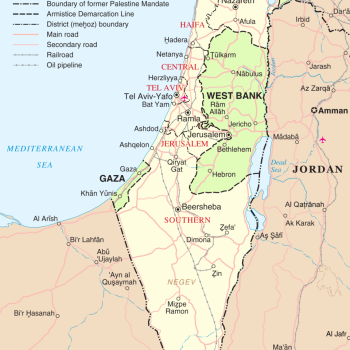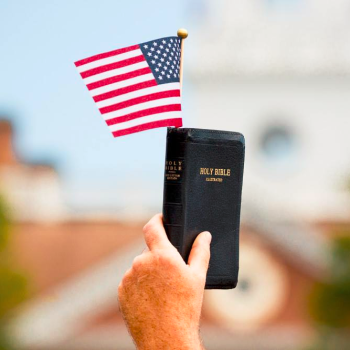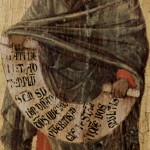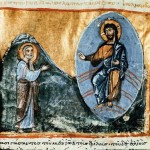What It’s About: A new covenant between God and Israel and Judah.
What It’s Really About: This is really about restoration. In the prophets, there is this sense of intense loss: current loss, or loss that has happened already, or loss that is yet to come. The prophets measure from an ideal–an apogee of righteousness and faithfulness that seems to have passed into history. But the prophets are also about looking forward to the time when that loss will be restored. That’s what these four verses are about: they’re about the time when God will restore the decimated Judah and Israel to their former positions. The language of covenant is the seal of that restoration; just as the former heights were reached by covenant, so will these be reached.
What It’s Not About: It’s not about Jesus. Or, at least, it doesn’t have to be. Remember: time only moves in one direction. Jeremiah didn’t know about Jesus. Jesus wouldn’t be born for centuries. But Jeremiah knew that God had not given up on God’s people, and that’s what he was on about. It’s completely legitimate to claim (and it’s completely legitimate not to claim) that Jesus represents a new covenant with God, and that Jeremiah unwittingly foretold something like what God was up to in the person of Jesus. But it wasn’t like Jeremiah was sitting around thinking up cryptic ways to talk about Jesus without really talking about Jesus. Jeremiah simply foresaw that God had not abandoned God’s people, and never would.
Maybe You Should Think About: If Jeremiah were reanimated today, would his message still be the same? Would Jeremiah–even with the life and ministry of Jesus in the rear-view mirror–still say that God is making covenants, that God is still looking for ways to be in relationship? I think so.
What It’s About: The divine spa treatment for the soul (have the big spa chains started marketing hyssop yet?).
What It’s Really About: A much more personal, individualistic vision of being made right with God.
What It’s Not About: It’s interesting to ask what kind of conception of “sin” was at work in the mind of the psalmist. Most people reading this blog will be Christians of one kind of another, living on this side of the Reformation. One of the hallmarks of Reformation theology is the emphasis on the abject sinfulness of humanity. (That’s certainly what I had in mind as a teenager, singing verses 10-12 at summer camp worship services). But we can’t simply transpose our 21st century sins onto antiquity without bending the text to suit our needs. And that’s fine–that’s what all readings of ancient texts do–but we should be aware of it. It’s not about us, in its historical context. It can certainly apply to us, and it does, but we didn’t write it. What did the writer have in mind?
Maybe You Should Think About: Look at God in this Psalm. This is a God who has the power to “purge” and “blot out” sin and remain in the presence of sinfulness. And this is quite apart from Jesus (who, again, doesn’t exist yet), and there is no mention of the temple sacrificial system. We have this tendency to view God as a legalistic pedant, who simply isn’t able to forgive the shortcomings of humans unless certain conditions are met. But look at this God! This is a God who forgives sin because that is what God does.
What It’s About: Jesus as high priest.
What It’s Really About: This is a tough one. Scholars debate what, exactly, is going on in Hebrews. I have a thing I sometimes tell my New Testament students: that “Paul’s Epistle to the Hebrews” wasn’t written by Paul (it doesn’t claim to be), isn’t an epistle, and wasn’t written to the Hebrews. The best guess out there is that this book is a sermon, delivered to Christians in the city of Rome sometime in the first century. And we can surmise from the book’s content that the author assumed a lot of knowledge about Israelite history, so perhaps there were Jewish Christians in the audience. But how we think about the audience really matters for how we interpret the text. When the author talks about Melchizedek, what does he or she (probably he, but since it’s anonymous we don’t know for sure) hope to get across? This is really a fascinating view into a separate, non-Pauline, non-Johannine, and probably non-synoptic way of explaining who Jesus was and why he was important.
What It’s Not About: It’s not about supercessionism. Remember: audience. These are people that the author expected would know Israelite history inside and out. These were probably Jews. So it’s not a sermon demonstrating Jesus’ triumph over an old priestly system. It’s a sermon demonstrating that Jesus fits within that system, and is in the best tradition of that system.
Maybe You Should Think About: Once, when faced with preaching this text, I finally threw up my hands and spent the sermon time explaining who Melchizedek was and why the author of Hebrews thought Jesus was comparable. It was basically a history lesson, but it was one that people really seemed to appreciate. The bible is full of obscure and confusing stuff like Melchizedek (that’s why ministers go to specialized school for three years!), so sometimes it’s really useful to the congregation for the minister to step back and explain what’s going on behind the scenes of a text. Not everyone knows the intricacies of the royal houses of pre-Abrahamic Salem. But you do! Or at least you will after doing some research.
What It’s About: Horticulture.
What It’s Really About: Jesus predicting his own death–and revealing something of his purpose.
What It’s Not About: This is not a parable; the Gospel of John doesn’t contain any parables. But this is as close as Jesus comes to using parabolic language in the gospel. You can almost hear the way this would have been framed in the synoptic gospels: “There once was a seed of grain that was sown….” Jesus, here, is employing the language of nature, and in this case the fecundity of nature, to talk about the power of purpose.
Maybe You Should Think About: March 20th is the Vernal Equinox, the day when day and night are of equal length, and the day when Spring “officially” begins (leave it to humans to declare themselves the guardians of the seasons). It’s no accident that (in Western Christianity at least) Easter is pegged to the equinox (though not without historical controversy). It is a season of renewal, resurrection, rebirth, and revival. So why not take this opportunity to do something unusual and tactile with your worship service? Print the bulletin on paper with seeds embedded in it, and ask people to plant the paper in their gardens and wait for the growth to come. Or, pass out seeds as part of the service, and invite people to live this non-parabolic parable that Jesus told those people gathered for Passover some two thousand Vernal Equinoxes ago.



